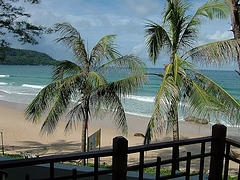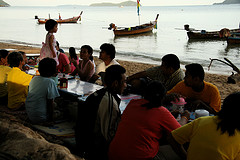 About
Phuket Island About
Phuket Island
Phuket Island has a long recorded history dating back to
A.D. 1025. Records indicate that the island's present-day
name derives in meaning from the Tamil "manikram," or
Crystal Mountain. For most recent history Phuket Island was
known as "Junk Ceylon," which, with variations, is the name
found on many old maps. The name is thought to have its
roots in Ptolemy's Geographia, written by the Alexandrian
geographer in the Third century A.D. He mentioned that in
making a trip from Suwannapum to the Malay Peninsula it was
necessary to pass the cape of Jang Si Land.

Phuket was a
way station on the route between India and China where
seafarers stopped to shelter. The island appears to have
been part of the Shivite empire (called in Thai the Tam Porn
ling) that established itself on the Malay Peninsula during
the first Millenium A.D. Later, as Muang Takua-Talang, it
was part of the Srivichai and Siri Tahm empires. Governed as
the eleventh in a constellation of twelve cities, Phuket's
emblem, was the dog.
During the
Sukothai Period Phuket was associated with Takua Pah in what
is now Phang-nga Province, another area with vast tin
reserves. The Dutch established a trading post during the
Ayuthaya Period in the 16th Century. The island's northern
and central regions then were governed by the Thais, and the
southern and western parts were given over to the tin trade,
a concession in the hands of foreigners.
After
Ayuthaya was sacked by the Burmese in 1767 there was a short
interregnum in Thailand, ended by King Taksin, who drove out
the Burmese and re-unified the country, the Burmese,
however, were anxious to return to the offensive. They
outfitted a fleet to raid the southern provinces, and carry
off the populations to slavery in Burma. This led to
Phuket's most memorable historic battle led by the two
heroines, Kunying Jan, wife of Phuket's recently deceased
governor, and her sister Mook.
After a month's siege the Burmese were forced to depart on13
March, 1785. Kunying Jan and her sister were credited with
the successful defense. In recognition King Rama I bestowed
upon kunying Jan the honorific Thao Thep Kasatri, a title of
nobility usually reserved for royalty, by which she is still
know today. Here during the Nineteenth Century Chinese
immigrants arrived in such numbers to work the tin mines
that the ethnic character of the island's interior became
predominantly Chinese, while the coastal settlements
remained populated chiefly by Muslim fishermen.
In Rama V's reign, Phuket became the administrative center
of a group of tin mining provinces called Monton Phuket, and
in 1933, with the change in government from absolute
monarchy to a parliamentary system, the island was
established as a province by itself.
Location and Boundaries
 Phuket is an
island in the Andaman Sea along Thailand's Southern and
Western coast and is connected by bridges to southern
Thailand's mainland. Phuket is an
island in the Andaman Sea along Thailand's Southern and
Western coast and is connected by bridges to southern
Thailand's mainland.
Phuket Island can be located on a map between the Northern
latitudes of 7' 45" and 8' 15" and between 98' 15" and 98'
40" West Longitude, The Andaman Sea being part of the Indian
Ocean.
As Thailand's largest island, Phuket is surrounded by 32
smaller islands which part of the same administration.
Phuket Island has a total land area of 570 square
kilometers, about the same as the island of Singapore.
Measured at its widest point, Phuket is 21.3 kilometers; at
its longest, 48.5 kilometers.
Phuket Island's boundries are:
On the North: Lies the Pak Prah Strait, spanned by two
bridges running side-by-side, the older Sarasin Bridge, and
the newer Thao Thep Krasatri Bridge.
On the South: Is the Andaman Sea.
On the East: Is Ao Phang-nga Bay (Mainly under the
jurisdiction of Phang Nga Province).
On the West: Is the Andaman Sea.
 Geography Geography
About 70% of Phuket is mountainous; a western range runs
from north to south from which smaller branches derive. The
highest peak is Mai Tao Sip Song, or Twelve Canes, at 529
meters, which lies within the boundaries of Tambon Patong,
Kathu District. It has recently been capped by a radar
station which has a beautiful public access road to within
meters of the station. The remaining 30% of the island,
mainly in the center and south, consists of low plains.
There are numerous streams including the Klong Bang Yai,
Klong Ta Jin, Klong Ta Rua, and Klong Bang Rohng, none of
which are large.
Climate
Phuket's weather conditions are dominated by monsoon winds
that blow year round. It is therefore always warm and humid.
There are two distinct seasons, rainy and dry. The rainy
season begins in May and lasts till October, during which
the monsoon blows from the southwest, The dry season is from
November through April, when the monsoon comes from the
northeast. Highest average temperatures, at 33.4 degrees
Celsius, prevail during March.Lowest averages occur in
January, when nightly lows dip to 22 degrees Celsius.
 Economy Economy
Since the early 1980's the tourist business has been
Phuket's chief source of income. Hotels, restaurants, tour
companies, and souvenir shops are much in evidence on the
West Coast, However, while once all-important tin mining has
ceased, tourism is by no means the island's only activity.
Agriculture remains important to a large number of people,
and covers by far the most part of the island. Principal
crops are rubber, coconuts, cashews, and pineapples,
Pineapples, Prawn farming has largely taken over the east
and south coasts. Pearl farming is also important. Phuket's
fishing port is at all times filled, and processing of
marine products, mainly fish, makes a significant
contribution to the economy.
With so many healthy industries supplying income,
construction has become a major factor in employment. This
ranges from massive public works projects, large office
buildings and hotels, and housing estates with hundreds of
units, down to single family homes, apartments and
additions.
Population
Official population as of December 31, 1998, was 231, 206.
This figure numbers those who are registered as living in
Phuket. Phuket's attraction as a center of economic activity
has resulted in many living on the island whose registration
is elsewhere. The total population of Phuket varies
considerably depending on the time of year, though it is
never less than figure given above.
Government
The island is divided into three districts, Talang in the
north, Kathu in the west, and Muang in the south. Thailand's
system of government relies upon a strong central authority,
thus the Provincial Governor is a civil servant appointed by
the Interior Ministry in Bangkok, as are the Nai Amper, or
District Chief. The cities of Phuket and Patong have their
own city governments, with elected city councils, the
leading members of which serve as mayor. There are also
elected provincial, district, and sub-district, or Tambon
councils. The local constabulary is part of the Interior
Ministry.
|